Parks Maintenance & Recreation Management in the Peace River Country of Alberta
RESPECTING WILDLIFE
HOME . . . ABOUT . . . CONTACT . . . ATV SAFETY
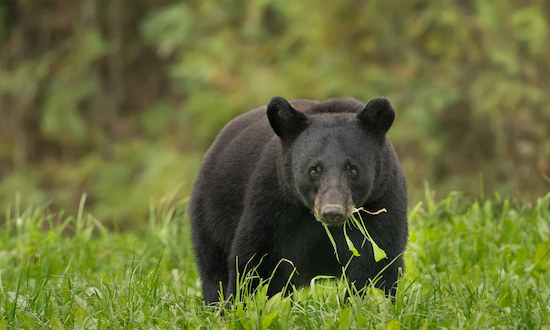
BLACK BEARS
Bears are much like people, some bears are more tolerant than others, but like people every bear has a “personal space” which is the distance within which a bear feels threatened. If you stray within that zone, (too close) a bear may react aggressively.
Don’t teach bears that human food or garbage is an easy meal. It is both foolish and illegal to feed bears, either on purpose or simply leaving food or garbage that attracts them. When camping, hang food out of reach of bears if possible. A bear will destroy a cooler or even tear the door off of a camper to get food. Pets and their food may also attract bears. Wearing perfume or perfumed hair spray in the woods can attract a bear.
Keep pets tied up. A dog may run after a bear and then come howling back after being smacked and bring the bear right into camp.
Keep a clean camp. Wash your dishes. Food and garbage are equally attractive to a bear so treat them with equal care. Burn and bury your garbage deep.
If you see a bear, avoid it if you can. Give the bear every opportunity to avoid you, such as making noise. If you do encounter a bear at close distance, remain calm. Attacks are rare. Chances are, you are not in danger. Most bears are interested only in protecting food, cubs or their “personal space.” Once the threat is removed, they will move on. Let the bear know you are human. Talk to the bear in a normal voice, back away, don't stare at him. Help the bear recognize you. If a bear cannot tell what you are, it may come closer or stand on its hind legs to get a better look or smell. A standing bear is usually curious, not threatening. You may try to back away slowly but if the bear follows, stop and hold your ground.
NEVER run! YOU CANNOT OUT RUN A BEAR. They can move 30 ft. per second and like dogs, they will chase fleeing animals. Bears often make bluff charges, sometimes within 10 feet of their adversary without making contact. Hold your coat above your head and stand on a mound or a log to make yourself look bigger. Talk to the bear. If the bear gets too close, raise your voice and be more aggressive. Bang pots and pans. Use noisemakers. Never imitate bear sounds or make a high-pitched squeal. Look for a weapon, a good solid stick works good.
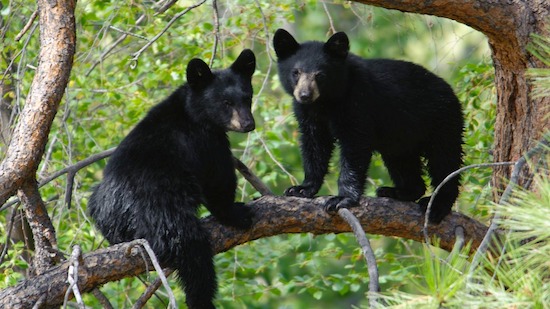
Fight Back!
If a bear actually makes contact, initially use the stick as hard as you can on his nose as many time as possible all the while making lots and lots of noise. If the bear won't back down and continues to attack, surrender! Fall to the ground and play dead. Lie flat on your stomach, or curl up in a ball with your hands behind your neck. Typically, a bear will break off its attack once it feels the threat has been eliminated. Remain motionless for as long as possible. If you move, and the bear sees or hears you, it may return and renew its attack. In rare instances, particularly with black bears, an attacking bear may perceive a person as food. If the bear continues biting you long after you assume a defensive posture, it likely is a predatory attack. Fight back vigorously. Punch it in the nose, or use a knife to stab its nose.
Be prepared, carry a weapon - there are literally hundreds of thousands of bears in Canada, if you are in the back country you will see a bear.
When in the forest always be prepared. Always carry a good knife. Pepper spray works well or a can of quick start engine spray for starting diesel engines. If you prepare the can so that it is quickly accessible, you can spray that in the bear's face and if he is very aggressive and persistent, strike a windproof lighter and spray over top of the flame. With this, you may start the forest on fire but you have an effective weapon against bears or any other animal. A can of quick start works well against any kind of predatory animal.
COUGAR / MOUNTAIN LION
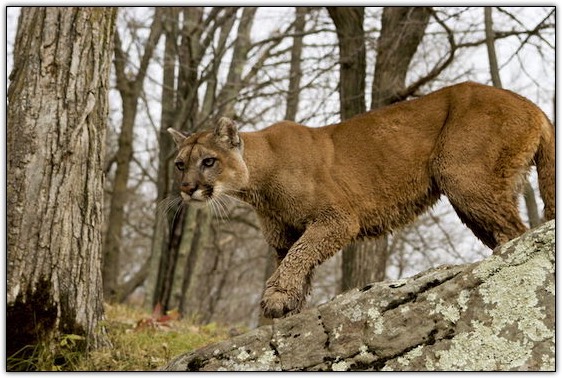
Cougars are great stalkers. Try your best to avoid them or startle them. This means making lots of noise as you hike along. Again, like a bear, if you encounter one, back away and don't intimidate it. Make sure you don't corner the animal. A cougar often hunts from above so keep your eyes on the trees ahead of you as you hike. They may let you pass and then drop down behind you and stalk you so quietly you can't hear them coming. When I'm hiking I glance back regularly for this purpose.
If you encounter a cougar, stay calm, don't run, walk away backward keeping your eyes on the animal. If it show signs of aggression make your self look as large as possible, pull your jacket up over your head to appear taller and stand on something to look bigger. Make lots of noise.
Look for a weapon. Again, bear spray may work well or a can of ether quick start and a wind proof lighter to deter the threat. (Not many animals will stand up to a blast of flame!) A walking stick can make a good weapon. Always aim for the eyes and nose. Many people have survived a cougar attack by fighting back, even with a jack knife or a stick.
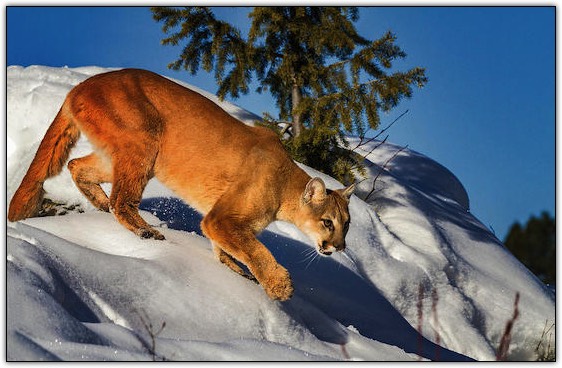
Agressive Moose
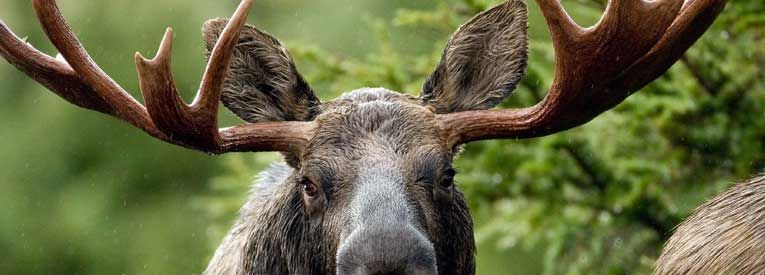
(Image credits: survivalgrounds.com)
We all know that a Bear or Cougar can be dangerous but most people don't see a plant eating moose as a threat. According to authorities (and Wikipedia) moose do attack and injure humans more often than any other animal. With a moose there is no safe side to approach, they can kick forward, backward and sideways.
The number one rule to avoid a conflict with a moose
is to maintain a safe distance
Yes, a moose can be a real threat, in fact every year there are disastrous altercations between moose and people. This usually happens when the animals are trying to protect their young or are cornered and afraid.
A moose is fully capable of fending off bears and wolves!
A moose can attack with their teeth, feet and antlers, they will charge you and have been known to rip the door right off of a pick up truck when angry. They are not normally aggressive but can be when they are harassed by people or dogs. They can also be irritable when suffering with ticks or are hungry and tired. Highway traffic can make them irritable and are easily upset when humans bother them.
Much like humans, moose have a personal space that they don't want you to invade and a personal tolerance level depending on the situation and that particular moose.
Moose often charge but most charges are bluffs. This is a warning to stay away. In the event that they do charge don't wait around to see if it really might be a bluff, take cover, run for a building, a vehicle or get under something safe. Even a moose calf can weigh 3 - 400 pounds so an altercation could kill you.
Stay back from wild animals don't put them in a situation where they become agitated or aggressive. A moose generally won't chase you very far but if they can catch you they'll decimate you with their front feet and their antlers.
Bull moose are not usually intimidated like the cow moose is, however, during rut they can be aggressive toward humans. Spring and summer are the critical time for a cow that may have a calf or two. They will defend their calfs so stay far away. If you see a calf on its own don't go near, mom will not be far away.
These are not zoo animals. Animals in the wild are inherently dangerous. Remember, if you come across one in the wild, you are in their living room, as far as they are concerned you don't belong there.
Never attempt to feed a moose or any other wild creature. This can end up in a real bad situation for both you and the animal. A moose or any other animal that walks toward you is not looking for companionship, they maybe looking for a handout but this is usually a sign of danger. Animals can become aggressive if they come to you and don't get what they want. At this point retreat is your best option, get under cover, in a vehicle, a building up a tree wherever.
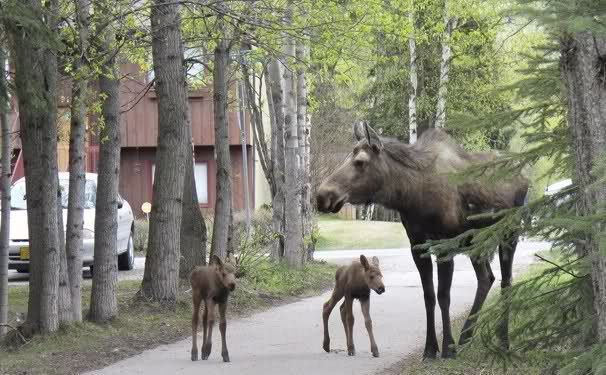
(image credits: hardboilednews.com)
Signs of Attack!
When observing a moose watch for signs of agitation that would indicate they are upset or are preparing to attack. The long hairs on its hump will raise up, their ears will lay back and they may begin to lick their snout. If a moose maintains eye contact with you it is a sign of aggression.
A moose with its hackles raised is a thing to fear!
Remember, the number one rule to avoid a conflict with a moose is to maintain a safe distance:
Some of the most dangerous attacks by a moose are triggered by dogs. A moose sees a dog (like a coyote or a wolf) as an enemy.
Authorities tell us that if you're knocked down by a moose, just roll up in a ball and don't fight back. They say fighting back will cause the moose to continue to strike with its front feet. As for me, I still carry my can of quick start ether, (you might have bear spray with you) I believe I would employ that before I would lay down and take a beating.
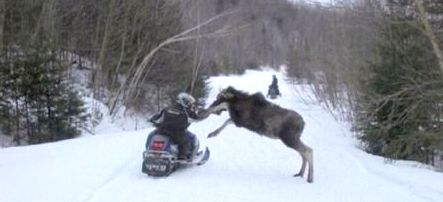
(Photo credits: Pinterest)
The moose population In Canada is over 1,000,000 so there is a very good chance you will encounter one of these in the out doors.